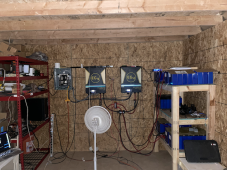RoySalisbury
New Member
- Joined
- Apr 24, 2022
- Messages
- 136
I have now completed my 5th (out of 8) pack for my DIY system (16x280ah in each bank). I switched away form JDB over to JK BMS for the active balance capabilities and this has helped stabilize the voltage differences between cells and between the 5 BMS's.
But I am wondering, of the folks that have larger banks (48 or more cells), do you just manage multiple BMS's individually, or have you moved on from "single" pack BMS's to something that can communicate between packs? For example, the JK or JBD BMS are basically "stand alone" BMS's that monitor a single 4/8/16 cell pack. But the All-In-One (not DIY) systems like EG4, are designed to be "daisy chained" together so they can act as one large bank. This allows them to communicate with the inverters and help manage the charging better.
I have noticed that a "one size fits all" charging profile just does not seem to be the right choice when you have multiple packs and they have slightly different charge cycles. I have 2 EG6500EX inverters and when dealing with the battery "source" all it knows is basically the voltage because it has no communication to the BMS. So the only charging "profile" it has is voltage (bulk/float) and max current. And its SOC is rarely if ever correct (because it just uses the voltage).
It also cant adjust the charge current based on SOC when getting closer to 100%. This is actually both a BMS and inverter thing, but the JK or JBD BMS do not have any type of current limit other than "max" current, so I need to adjust the inverters max charge current the closer it gets to 100%. if not you can get spikes of "over voltage" in some cells that causes the BMS to turn on/off, while other cells don't get fully charged (this is where the active balancer helps).
Anyway, what are some recommendations/ideas that folks have? In the end I will have 8 packs 16x280ah (for a total of about 114 kwh), and would like to start getting some better management in place.
Roy
But I am wondering, of the folks that have larger banks (48 or more cells), do you just manage multiple BMS's individually, or have you moved on from "single" pack BMS's to something that can communicate between packs? For example, the JK or JBD BMS are basically "stand alone" BMS's that monitor a single 4/8/16 cell pack. But the All-In-One (not DIY) systems like EG4, are designed to be "daisy chained" together so they can act as one large bank. This allows them to communicate with the inverters and help manage the charging better.
I have noticed that a "one size fits all" charging profile just does not seem to be the right choice when you have multiple packs and they have slightly different charge cycles. I have 2 EG6500EX inverters and when dealing with the battery "source" all it knows is basically the voltage because it has no communication to the BMS. So the only charging "profile" it has is voltage (bulk/float) and max current. And its SOC is rarely if ever correct (because it just uses the voltage).
It also cant adjust the charge current based on SOC when getting closer to 100%. This is actually both a BMS and inverter thing, but the JK or JBD BMS do not have any type of current limit other than "max" current, so I need to adjust the inverters max charge current the closer it gets to 100%. if not you can get spikes of "over voltage" in some cells that causes the BMS to turn on/off, while other cells don't get fully charged (this is where the active balancer helps).
Anyway, what are some recommendations/ideas that folks have? In the end I will have 8 packs 16x280ah (for a total of about 114 kwh), and would like to start getting some better management in place.
Roy



